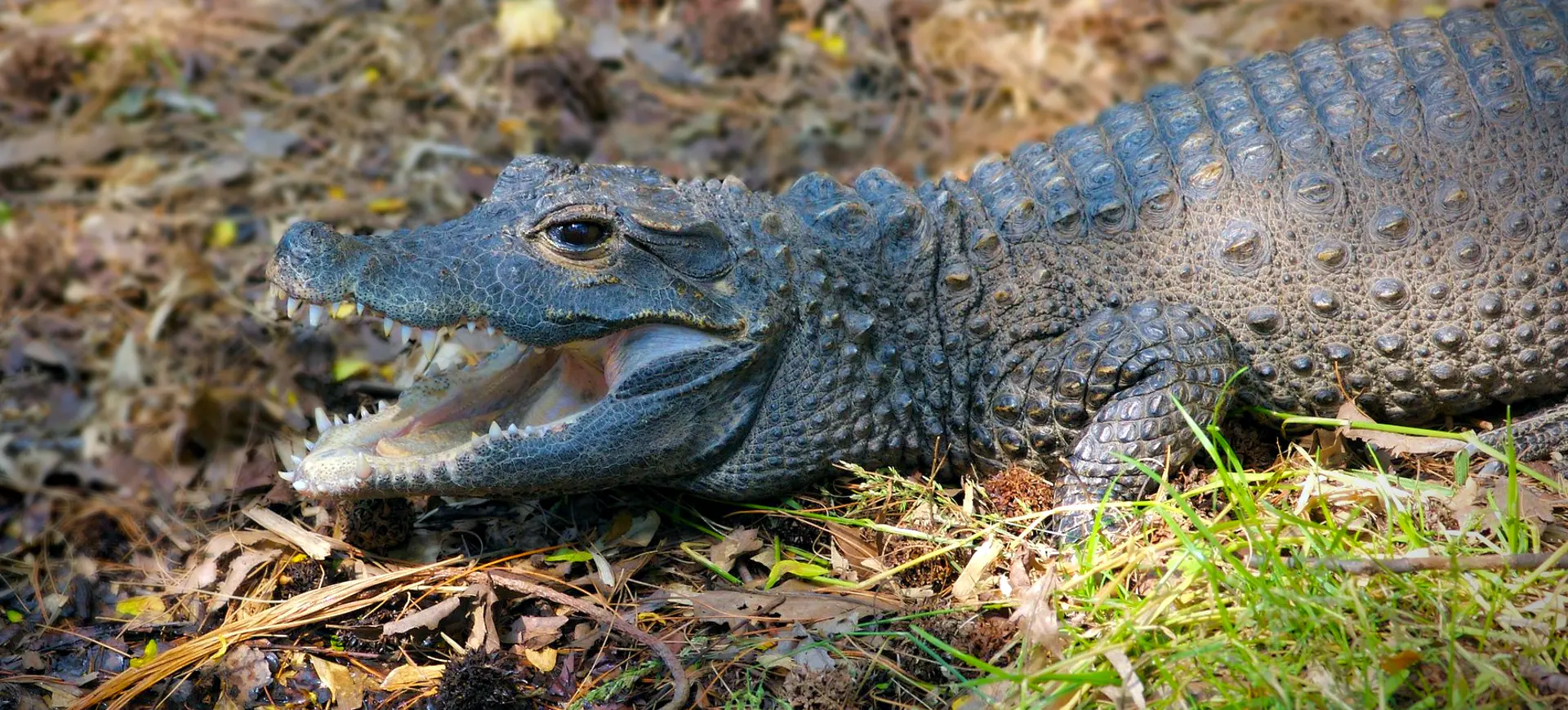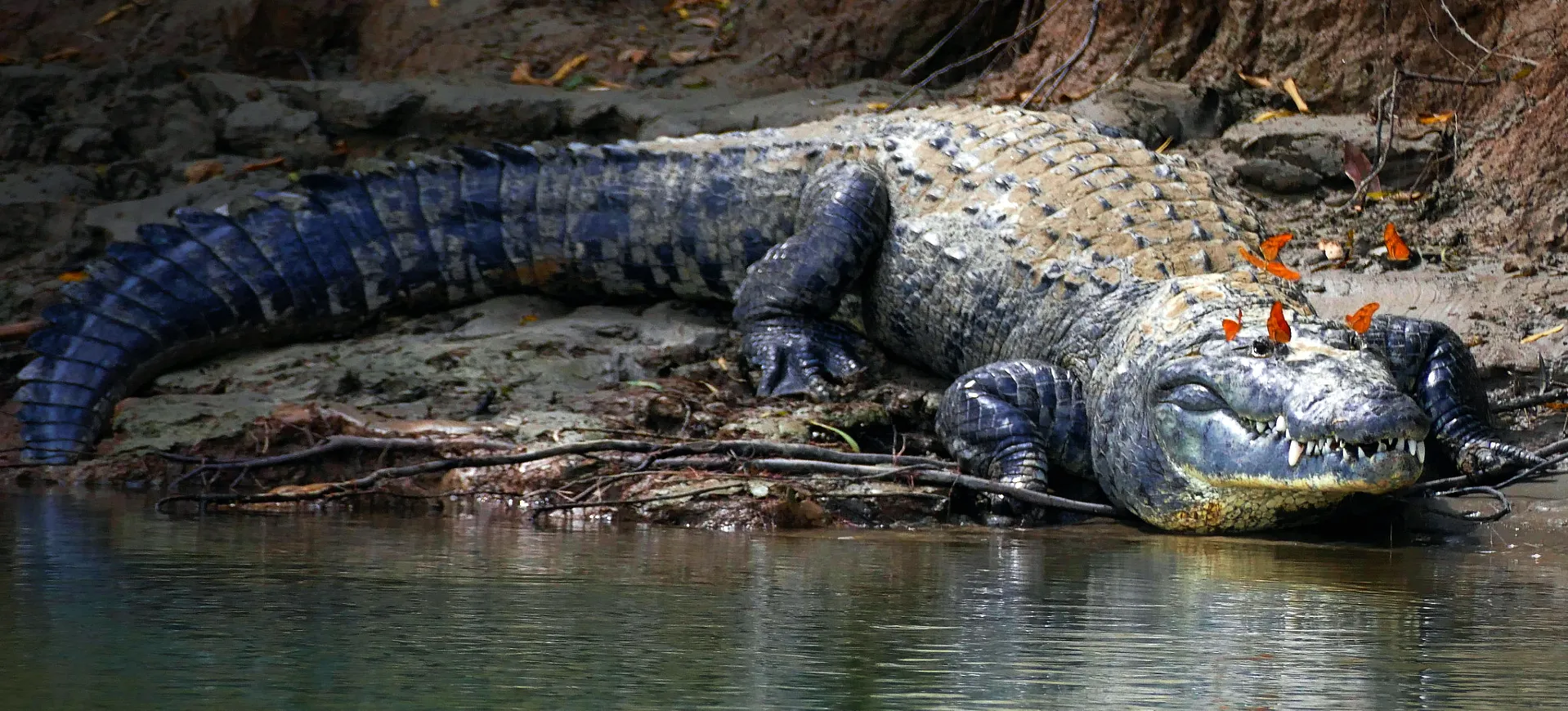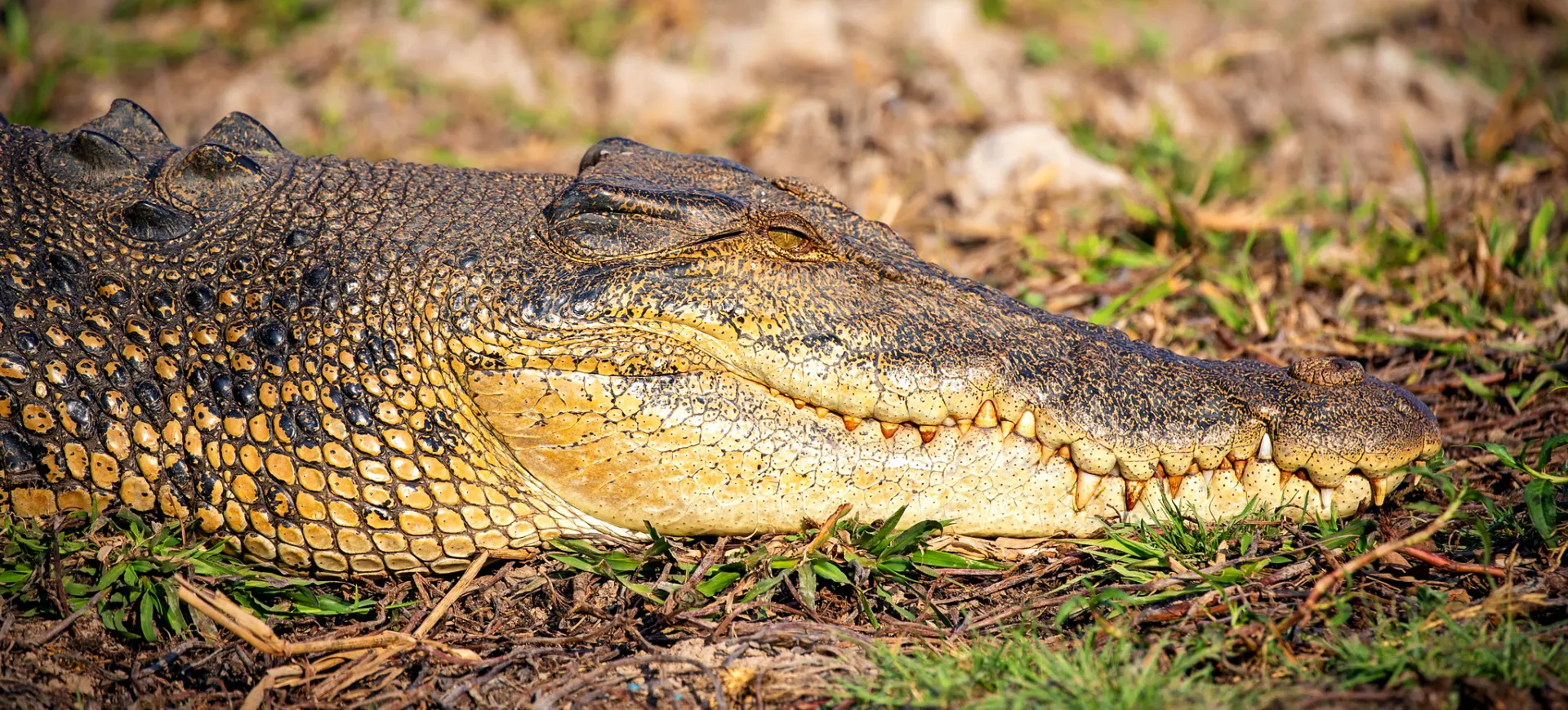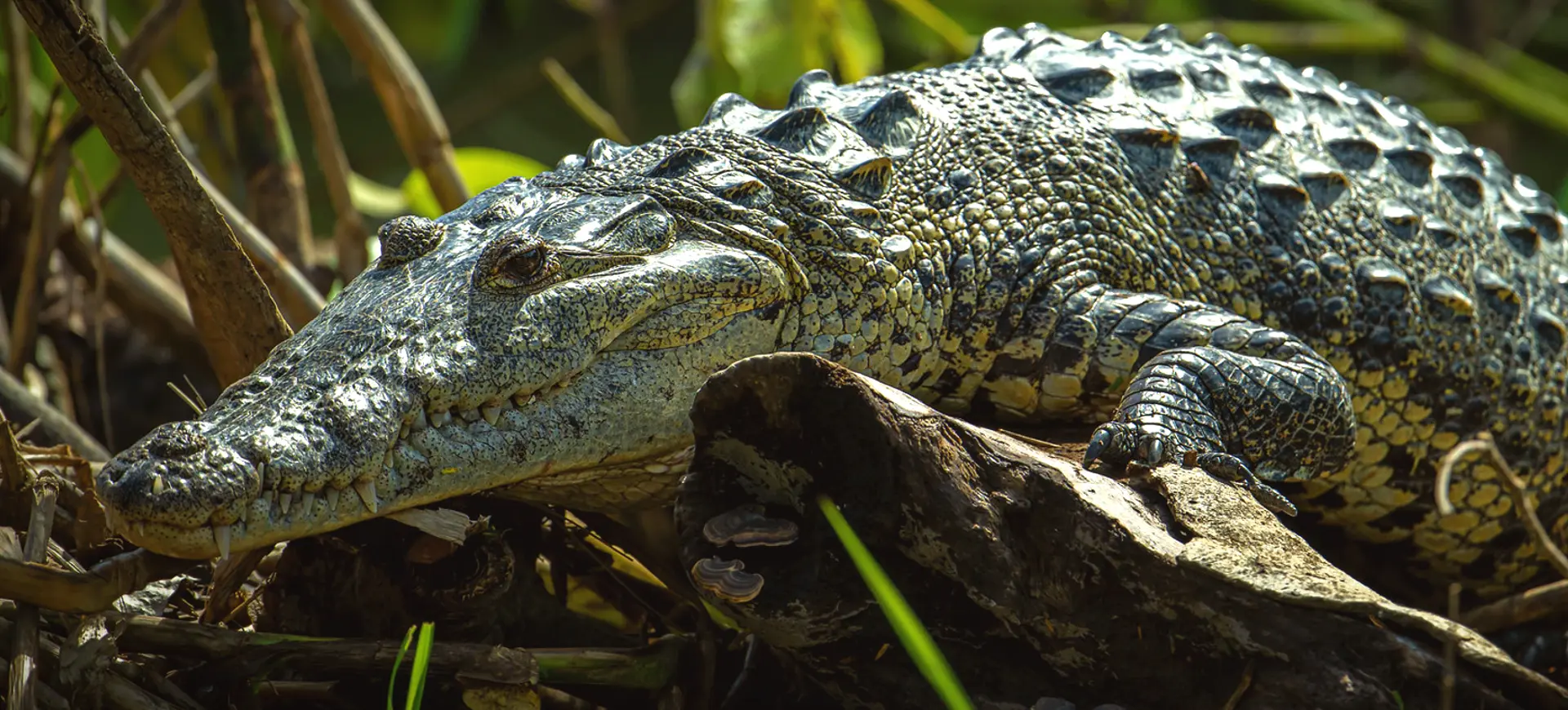Overview
The Nile Crocodile is one of the largest crocodilian species and is native to African freshwater habitats. It is a formidable predator, equipped with strong jaws and sharp teeth, capable of taking down a variety of prey, including fish, birds, and large mammals. The species is known for its aggressive nature and is responsible for more attacks on humans than any other crocodilian species.
Adult Nile Crocodiles have a dark bronze coloration, which serves as camouflage in their aquatic environments. Juveniles are darker, with black cross-banding on the tail and body. The species is sexually dimorphic, with males being significantly larger than females. They have a V-shaped snout, distinguishing them from other crocodiles with a more U-shaped snout.
Nile Crocodiles are highly adaptable and can be found in various freshwater habitats, including rivers, lakes, and marshlands. They are ectothermic, relying on external sources to regulate their body temperature. This often involves basking in the sun during the day and staying in the water during the cooler night hours.
Taxonomy
Kingdom
Phylum
Class
Order
Family
Genus
Species
Type
Physical Description:
The Nile Crocodile is a large and robust reptile, with adult males reaching lengths of up to 16 feet and weighing as much as 1,650 pounds. Females are generally smaller, with maximum lengths of around 12 feet and weights up to 1,000 pounds. The skin is heavily armored with osteoderms and bony plates that provide added protection.
The species has a V-shaped snout equipped with numerous sharp teeth. The eyes, ears, and nostrils are located on the top of the head, allowing the crocodile to submerge most of its body while still being able to see, hear, and breathe. The limbs are short but powerful, and the tail is muscular, aiding in swimming.

Lifespan: Wild: 50-80 years || Captivity: 50-80 years

Weight: Male: 1,100–1,650 lbs (500–750 kg) || Female: 500–1,000 lbs (227–454 kg)

Length: Male: 12–16 ft (3.6–4.8 m) || Female: 8–12 ft (2.4–3.6 m)

Top Speed: 8–11 mph (13–18 km/h)
Characteristic:
Native Habitat:
Nile Crocodiles are native to many freshwater habitats across Sub-Saharan Africa. They are commonly found in rivers, lakes, and marshlands. These environments provide them with ample hunting opportunities and serve as nesting sites during the breeding season.
The species is highly adaptable and can tolerate various environmental conditions, including seasonal variations in water levels. They are known to travel long distances in search of suitable habitats, particularly during periods of drought when water sources may become scarce.
Climate Zones:
Biomes:
Biogeographical Realms:
Continents:
Countries:
Diet:
Diet & Feeding Habits:
Nile Crocodiles are apex predators with a varied diet that includes fish, birds, and mammals. They employ a “sit-and-wait” strategy, lurking near the water’s edge to ambush unsuspecting prey. Once the prey is within reach, they strike quickly, dragging it underwater to drown before consuming it.
The species is known for its powerful bite, which allows it to tackle large prey such as wildebeest and zebras. They also exhibit cooperative hunting behaviors, particularly when taking down larger animals. This involves multiple individuals working together to isolate and subdue the prey.
Mating Behavior:
Mating Description:
Nile Crocodiles have a polygynous mating system, where dominant males mate with multiple females. During the breeding season, males engage in aggressive displays and fights to establish dominance and secure access to females. Once a male has won the right to mate, he will engage in a courtship ritual that involves gentle touching and vocalizations.
Females lay their eggs in nests made of vegetation and mud, usually near the water’s edge. They are highly protective of their nests and guard them until the eggs hatch. Once the young are born, the mother helps them reach the water and may provide some level of care, including protection from predators, for several months.
Reproduction Season:
Birth Type:
Pregnancy Duration:
Female Name:
Male Name:
Baby Name:
Social Structure Description:
Nile Crocodiles are generally solitary animals but can be found in loose aggregations, particularly in prime feeding or basking areas. These aggregations are not highly structured but are usually dominated by a larger, more aggressive individual. During the breeding season, males will establish territories and engage in aggressive displays to secure access to females.
Social interactions among Nile Crocodiles are limited but can include vocalizations and body postures to communicate. Aggressive interactions are common, particularly among males competing for access to females or prime basking spots. However, they also exhibit social tolerance, particularly when feeding, where multiple individuals may share a large kill.
Groups:
Conservation Status:
Population Trend:
Nile Crocodiles are widely distributed across Sub-Saharan Africa and are relatively abundant in many regions. They are particularly common in protected areas, where they benefit from conservation measures to preserve their habitats and regulate hunting. In some regions, they are considered a nuisance due to their predation on livestock and occasional attacks on humans.
Despite their wide distribution, Nile Crocodiles face habitat loss, hunting, and human-wildlife conflict threats. In some areas, populations are declining due to habitat degradation and overhunting. However, they are not currently considered endangered and are listed as “Least Concern” on the IUCN Red List.
Population Threats:
Nile Crocodiles face several threats, including habitat loss due to agricultural expansion and human settlement. They are also hunted for their skin, used in the leather industry, and for their meat. In some regions, they are considered a nuisance due to their predation on livestock and are killed to protect local communities.
Human-wildlife conflict is another significant threat, particularly in regions where they are abundant. Nile Crocodiles are responsible for more attacks on humans than any other crocodilian species, leading to negative perceptions and retaliatory killings. In some areas, they are also at risk from pollution and habitat degradation due to industrial activities.
Conservation Efforts:
Conservation efforts for the Nile Crocodile primarily focus on habitat preservation and sustainable hunting practices. Many countries have implemented hunting quotas and seasons to ensure stable populations remain. Protected areas like national parks and reserves also offer safe habitats where the species can thrive.
Community-based conservation programs also exist in some areas, involving local people in protecting and managing Nile Crocodile populations. These programs often include educational components to raise awareness about the ecological importance of the species and the need for sustainable management practices.
Additional Resources:
Fun Facts
- Nile Crocodiles are one of the largest crocodilian species.
- They are responsible for more attacks on humans than any other crocodilian species.
- Nile Crocodiles can hold their breath for up to 2 hours.
- They have a bite force of around 5,000 pounds per square inch.
- Nile Crocodiles are known to travel long distances in search of suitable habitats.
- They can live up to 100 years in the wild.
- Nile Crocodiles have a varied diet that includes fish, birds, and large mammals.
- They are known for their “death roll,” a technique to tear off chunks of flesh from larger prey.
- Nile Crocodiles have excellent night vision, thanks to a layer of cells in their eyes that reflect light.
- They can “high-walking,” a form of locomotion where they lift their bodies off the ground and move with a gait similar to mammals.












